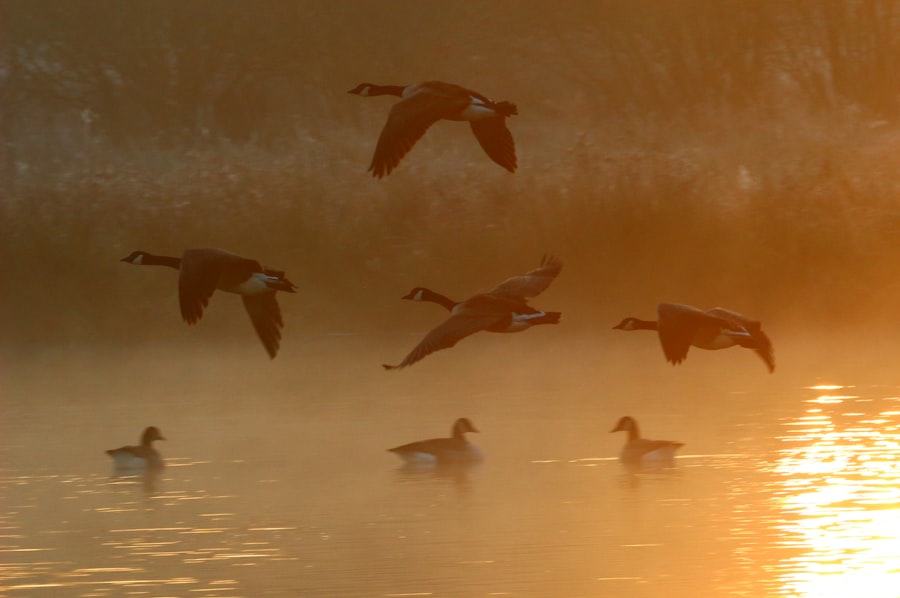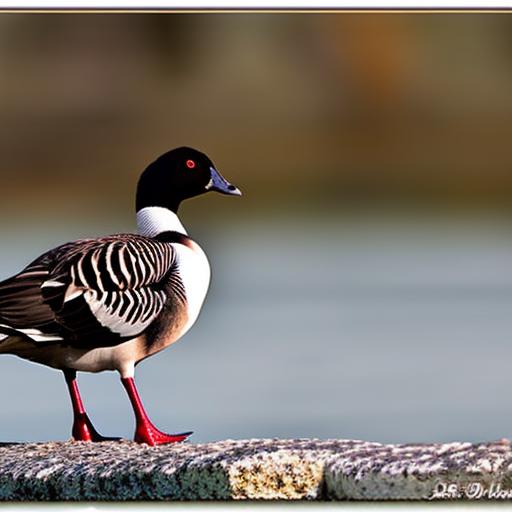Canadian geese are a common sight in many parts of North America, including Canada and the United States. While these birds can be beautiful to observe in their natural habitat, they can also become a nuisance when they invade urban areas, parks, golf courses, and other public spaces. The problem of Canadian geese overpopulation has become a growing concern, as their droppings can create unsightly messes and pose health risks. In order to address this issue, it is important to understand the behavior of Canadian geese and implement effective control methods.
Key Takeaways
- Canadian geese are social birds that mate for life and are highly protective of their young.
- Natural deterrents for Canadian geese include planting tall grasses and using decoys of predators or other birds.
- Chemical deterrents for Canadian geese include sprays that make grass taste bad or emit unpleasant odors.
- Physical barriers like fences, netting, and floating barriers can keep Canadian geese away from certain areas.
- Electronic devices like sonic repellents and flashing lights can also be effective in repelling Canadian geese.
Understanding the behavior of Canadian geese
Canadian geese are attracted to certain areas for several reasons. They are social animals that prefer to live in large groups, known as flocks or gaggles. These flocks often consist of extended family members and can number in the hundreds or even thousands. Canadian geese are also migratory birds, meaning they travel long distances in search of food and suitable nesting sites.
One reason why Canadian geese are attracted to urban areas is the availability of food sources. They are herbivores and feed on grasses, grains, and aquatic plants. Urban areas often provide an abundance of these food sources, such as well-maintained lawns and golf courses with lush grass. Additionally, bodies of water like ponds and lakes provide a suitable habitat for Canadian geese, as they use these areas for nesting and raising their young.
Natural deterrents for Canadian geese
One method of controlling Canadian geese is through the use of natural deterrents. Planting certain types of vegetation can discourage geese from settling in an area. For example, tall grasses or shrubs can make it difficult for geese to access open areas where they prefer to graze. Additionally, planting native plants that are less palatable to geese can help deter them from an area.
Another natural deterrent is the use of dogs. Border collies, in particular, have been trained to chase and harass geese, making them less likely to return to an area. The presence of a dog can create a sense of danger for the geese and encourage them to find a safer location.
Chemical deterrents for Canadian geese
Chemical deterrents can also be effective in repelling Canadian geese. There are several options available, including liquid repellents and taste aversion products. Liquid repellents are applied to grassy areas and emit an odor that is unpleasant to geese. Taste aversion products are added to grass or other vegetation and make it unappetizing for geese to eat.
While chemical deterrents can be effective, there are some potential drawbacks. They may need to be reapplied regularly, especially after rain or irrigation. Additionally, there is a concern about the environmental impact of these chemicals and their potential effects on other wildlife or water sources.
Physical barriers to keep Canadian geese away
Physical barriers can be an effective way to keep Canadian geese out of certain areas. Fencing or netting can be installed around ponds, lawns, or other areas where geese are not wanted. These barriers create a physical barrier that prevents geese from accessing the area.
When installing physical barriers, it is important to consider the height and design of the fence or netting. Geese are capable of flying over low fences or squeezing through small gaps in netting. Therefore, it is important to choose a barrier that is tall enough and has a design that prevents geese from getting through.
Electronic devices to repel Canadian geese

Electronic devices can also be used to repel Canadian geese. These devices emit sounds or lights that scare geese away. For example, there are devices that emit distress calls or predator sounds that mimic the natural sounds of geese in distress or the presence of a predator. There are also devices that use flashing lights to create a sense of danger for the geese.
It is important to note that electronic devices may not be effective in all situations. Geese can become habituated to certain sounds or lights over time, reducing their effectiveness. Additionally, these devices may not be suitable for all environments, such as areas with noise restrictions or where they may disturb nearby residents.
Scare tactics for Canadian geese
Scare tactics can be an effective way to deter Canadian geese from settling in an area. One common scare tactic is the use of decoys. These can be in the form of plastic or wooden replicas of predators, such as coyotes or owls. The presence of these decoys can create a sense of danger for the geese and discourage them from staying in the area.
Another scare tactic is the use of motion-activated sprinklers. These sprinklers are triggered by the movement of geese and spray water in their direction. The sudden burst of water can startle the geese and make them associate the area with danger.
Habitat modification to discourage Canadian geese
Modifying the habitat can also help discourage Canadian geese from settling in an area. One method is to remove or reduce food sources. This can be done by regularly mowing grassy areas to make it less appealing for geese to graze. Additionally, removing or reducing access to water sources, such as by draining ponds or installing barriers, can make an area less attractive for nesting and raising young.
Another method is to alter water features to make them less appealing to geese. For example, installing floating islands or vegetation rafts in ponds can create obstacles that make it difficult for geese to access the water. Additionally, adding underwater fencing or netting can prevent geese from landing on the water.
Professional services for Canadian geese control
In some cases, it may be necessary to hire professional services to control Canadian geese. These services often have specialized knowledge and equipment to effectively manage geese populations. They can provide a range of services, including habitat modification, egg addling (a method of preventing eggs from hatching), and the use of trained dogs to harass geese.
While professional services can be effective, they can also be costly. The cost will depend on the size of the area and the extent of the geese problem. It is important to carefully consider the benefits and costs before hiring a professional service.
Legal considerations when dealing with Canadian geese
When implementing control methods for Canadian geese, it is important to consider legal issues. In many areas, Canadian geese are protected under federal or state laws, which means that certain control methods may require permits or have restrictions. It is important to familiarize yourself with the laws in your area and ensure that any control methods used are legal and humane.
Additionally, it is important to consider the ethical implications of controlling Canadian geese. While they may be a nuisance in certain areas, they are still living creatures that deserve to be treated with respect. It is important to choose control methods that are humane and minimize harm to the geese.
Tips for preventing Canadian geese from returning
Once Canadian geese have been successfully deterred from an area, it is important to take steps to prevent them from returning. This can include ongoing maintenance of physical barriers or deterrents, as well as regular monitoring of the area for signs of geese activity. Additionally, it may be necessary to continue modifying the habitat or removing food sources to make the area less attractive for geese.
Controlling Canadian geese can be a challenging task, but with the right methods and strategies, it is possible to manage their populations and prevent them from becoming a nuisance. It is important to understand the behavior of Canadian geese and implement a combination of natural deterrents, physical barriers, electronic devices, scare tactics, habitat modification, and professional services to effectively control geese populations. Additionally, it is important to consider legal and ethical considerations when implementing control methods. By finding the right solution for each situation and taking proactive measures to prevent geese from returning, it is possible to maintain a balance between human needs and the natural environment.
If you’re interested in learning more about keeping chickens and how it can help deter Canadian geese, check out this informative article on Poultry Wizard. It provides valuable insights on where to put your chicken coop to maximize its effectiveness in keeping geese away. Discover the benefits of having a chicken coop in Grand Island, NE, and explore some creative ideas for large chicken coops. To learn more, click here: https://poultrywizard.com/keeping-chickens/where-to-put-chicken-coop/.
FAQs
What are Canadian geese?
Canadian geese, also known as Canada geese, are a species of waterfowl native to North America. They are known for their distinctive black heads and necks, white chinstrap markings, and brownish-gray bodies.
Why do people want to keep Canadian geese away?
Canadian geese can cause damage to property, create health hazards with their droppings, and become aggressive towards humans during nesting season. As a result, many people want to keep them away from their homes and businesses.
What are some methods for keeping Canadian geese away?
There are several methods for keeping Canadian geese away, including using decoys, installing fencing or netting, using noise deterrents, and applying repellents. Some people also use trained dogs to scare away geese.
Are there any humane methods for keeping Canadian geese away?
Yes, there are several humane methods for keeping Canadian geese away. These include using visual deterrents like reflective tape or balloons, using motion-activated sprinklers, and modifying the landscape to make it less attractive to geese.
Is it legal to harm Canadian geese?
No, it is illegal to harm Canadian geese under the Migratory Bird Treaty Act. This law protects migratory birds, including Canadian geese, from being hunted, captured, or killed without a permit.
Meet Walter, the feathered-friend fanatic of Florida! Nestled in the sunshine state, Walter struts through life with his feathered companions, clucking his way to happiness. With a coop that’s fancier than a five-star hotel, he’s the Don Juan of the chicken world. When he’s not teaching his hens to do the cha-cha, you’ll find him in a heated debate with his prized rooster, Sir Clucks-a-Lot. Walter’s poultry passion is no yolk; he’s the sunny-side-up guy you never knew you needed in your flock of friends!







